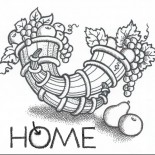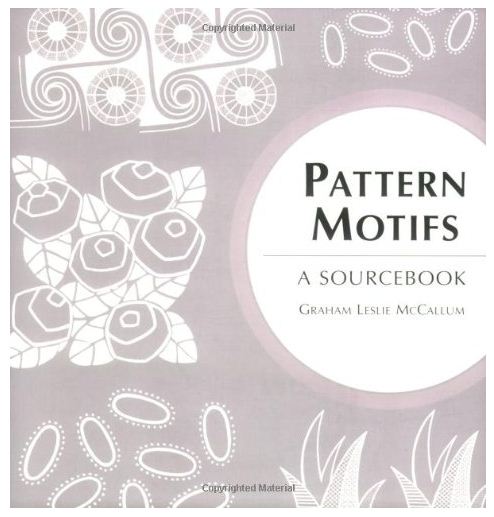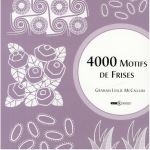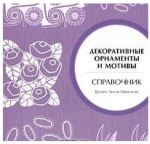Graham Leslie McCallum
The tree of happiness flowers and fruits most abundantly for the creative man
Pattern Motifs
INTRODUCTION
If we were to take a single motif, even the most simple of motifs, for example, a black dot and then placed several similar dots together, evenly spaced along an imaginary line- we will have created a linear pattern. There is something so visually pleasing in this most basic pattern, not only beautiful, but psychologically satisfying too. Extend that collection of dots vertically and you have amplified the pleasure effect.
This is precisely what our ancestors did 30 000 years ago. These cave-dwelling men and women discovered this aesthetic effect and carved this pattern onto their bone implements and painted it onto the walls of their rock shelters- and here we are, in the twenty-first century, still appreciating that very same pattern, only now, we call it the polka-dot pattern.
That you have picked up this book and taken the time to page through the patterns and motifs- is proof that you have an appreciation for patterning. Many scholars have theorized endlessly about the reason for mankind’s fascination for design, but like most of our desires and passions, the reasons lie deeply buried and locked-away within the complex psyche. However, I would like to think that as you explore through these wonderfully decorative pages, that you unlock that mystery and discover the secret to your personal passion for decoration.
In truth, the creative mind is not the only source for decorative patterns; the Natural World has pipped us to the post, producing some of the most beautiful and varied delights. Even our very finger and palm prints are Nature’s unique patterns imprinted on our hands. Taking a closer look at several wonderfully decorative tropical shells or the fascinating pelts of wild animals- is a humbling experience; indeed, you’d find it tremendously difficult to improve on nature’s originality.
Fortunately for us, thousands of talented artists and craftspeople, have preceded us and left an extraordinary wealth of motifs and patterns. The cultural creativity of the past not only provides a generous source of design and decoration, but also a wealth of motivating inspiration. It is like unlocking a chest and finding it brimming with jewels and finely-wrought treasures in gold and silver.
Within these pages, I have catalogued the many arrangements that we find pleasing, from mankind’s earliest Stone Age attempts, right through to the modern Art Deco style.
This volume contains many types of patterns: the chequered, the stellar, the scale-like, the spiraled, the arabesque, and many, many more. Some of these decorative styles were championed by different cultures and at different times. Greek design is a fine lesson in a restrained styling using a set number of design models, while the Gothic style is a good instructor of creative exuberance and the Japanese style a tutorial in simplicity.
These special and distinctive designs have been taken from many sources. Some are from the age-old pottery of the Neolithic Period- so bold and assertive in their dark brushstrokes. Others are from the intriguing jewellery of the Egyptian Dynasties, like those golden and enameled treasures discovered in the tomb of the Pharaoh Tutankhamen. Yet others were collected from the exquisite images painted on the walls of Minoan palaces. The mosaics of the Byzantines, the architectural friezes of Romanesque cathedrals and the maze-like relief-work on Chinese bronzes were the source for many more.
This wide field of motif and pattern sourcing, affords the user of this book many and varied applications.
In this age of digital cameras, personal computers, graphic software and colour printers, it is easy and quick for you to take a snap-shot of a flower in your garden and to print out as many images of it as you would wish for. Why is it then, that with all these electronic aids at our disposal- we still find the simple patterns and motifs, made up of basic shapes, lines and forms and executed by hand, to be more satisfying?
Here lies the crux of the mystery and the value in this book: we have a compelling drive to manipulate, extrapolate, redesign and re-interpret from nature. We are not content to simply photograph natural images for our decorative purposes, rather, we desire to leave the mark of our hands and to reveal our thought-processes for all to see and appreciate.
This book caters for this well-defined, enduring and classic creative tradition. Something of the life force, the movement of the designer’s hand, the passion, even the very soul of the artist, is forever captured in these motifs and patterns.
Fortunately, for those of you who want to simply capture a pattern for a project from this fine tradition, modern copying methods are quick and effective. All the artwork has been executed in fine and exacting detail for your visual enjoyment, for your inspiration and to assist you in your many creative pursuits. The black and white images in this publication, facilitates their accurate reproduction. The line-drawn images make hand-reproduction that much the easier. Many of the complex patterns have accompanying registration marks to help the user locate the beginning, midpoint and ending of pattern sequences. The reference dots indicate the scale to which the patterns were drawn and therefore will help with grid and hand-copying.
Please note- that you may only copy or adapt designs for your personal use.
I am certain that within this books rich heritage, you will find the style, the look and the type of motif and pattern that you are searching for to complete all your projects and I trust that the many beautiful images- will be the key to unlocking and releasing your own innate creativity.
Graham Leslie Mc Callum




Love this inspiring book. Sad that it’s out of print. Keep on borrowing the one copy from our public library. Thank you for creating this lovely book.